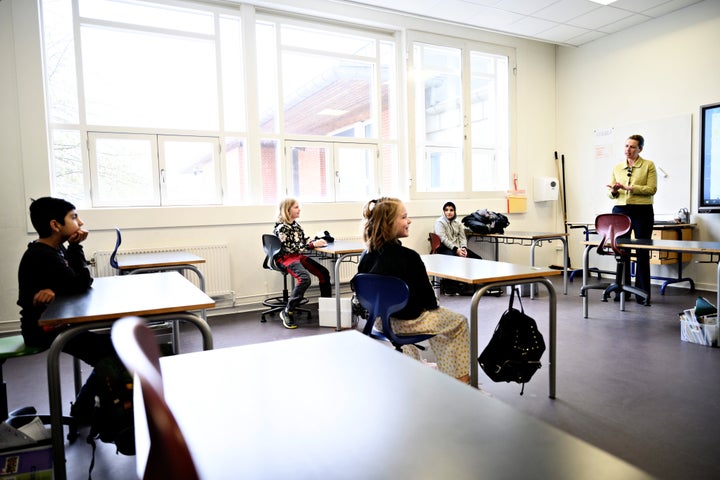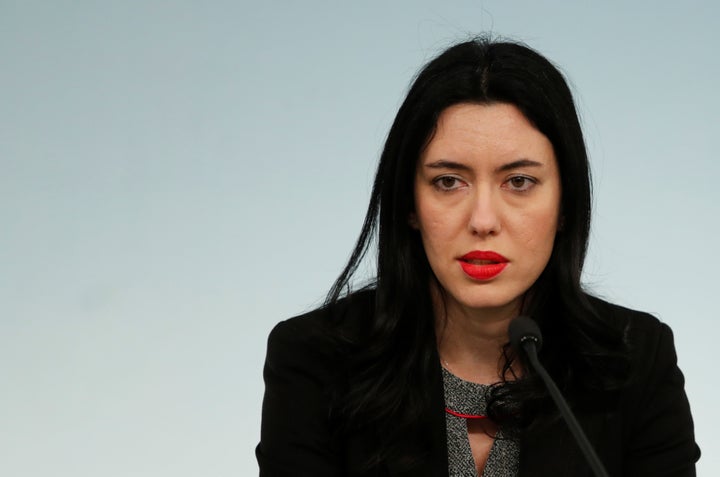Get the latest on coronavirus. Sign up to the Daily Brief for news, explainers, how-tos, opinion and more.
Children attending nurseries, kindergartens and primary schools in Denmark began returning to their classrooms this week, as the country became the first nation in Europe to reopen schools following a month-long closure due to the coronavirus pandemic.
The decision comes with a certain amount of risk. To prevent the coronavirus from spreading in schools, Danish health authorities issued strict hygiene and social distancing rules. Desks must be spaced out, children are allowed to play only in small groups during break times, and toys, tables, door handles and other surfaces must be disinfected at least twice a day.
In many schools, classes are being held outdoors so students and teachers can maintain a safe distance from each other.
“We’re all a bit nervous, and we’ll have to ensure that we stick to hygiene rules,” Elisa Rimpler, of the Danish Union of Early Childhood and Youth Educators, told the BBC. “We have a lot of washing hands during the day. We don’t have masks, and we have to keep a good distance from each other, so that’s a very difficult task.”
Despite these challenges, the question of when and how to reopen schools has become a primary concern for public officials around the world – not only because students who don’t have access to digital tools outside classrooms risk falling behind, but also because allowing children to attend school could also free their parents to return to work.
Other nations will soon follow Denmark’s lead. Norway plans to open kindergartens on April 20, followed a week later by primary schools. In Germany, students will start to return to school on May 4. In France, president Emanuel Macron announced this week that schools would begin to reopen on May 11. “This is a priority for me,” Macron said.

Australian prime minister Scott Morrison called on teachers to return to schools and be the “great heroes” of the country, and the premier of New South Wales is considering a system for rotating students through classrooms, according to HuffPost Australia.
In the UK, as well, where a nationwide lockdown has been extended until May and government officials have resisted any discussion of how restrictions may be relaxed, reopening schools may form a central part of any eventual exit strategy.
“From my understanding, there is a very strong desire by government to get the schools open,” Linda Bauld, a public health professor at the University of Edinburgh and former government adviser, told HuffPost UK. “Then the question is: do they have a phased return? For example, do they only allow half the class to go in and they teach for half a day? And then they rotate and the other half of the class go back in the afternoon? That seems to me possible.”
She added: “I think that in order to get more of the working-age population, the parents, at a better level, even if they’re still working from home, schools are going to be a priority.”
In Denmark, not all schools are open yet. Classes haven’t resumed in about half of Denmark’s municipalities, and about 35% of schools in Copenhagen have requested more time to prepare. All primary schools are expected to be open by April 20, while middle schools and high schools are not expected to open until May 10.
Some Danish parents are choosing to keep their kids at home. An online petition whose name translates as “my child is not a guinea pig” has garnered approximately 18,000 signatures, according to Agence France-Presse.
Italian politicians have been eager to discuss plans for “phase two” of their country’s coronavirus response, when lockdown restrictions may start to be lifted. Lucia Azzolina, Italy’s education minister, said this week that schools would remain closed for the time being, however, because the risk of spreading the coronavirus was too high.
“The possibility of reopening in May is becoming increasingly distant,” Azzolina said, according to HuffPost Italy.

Doctors and teachers in other countries have also expressed concerns about reopening schools. The president of the Federation of French Doctors, Jean-Paul Hamon, said this week that sending children back into classrooms represented “an unnecessary risk”.
“Children do not necessarily follow instructions – they will naturally play together and they risk bringing the virus home,” Hamon said.
Katharine Birbalsingh, a headteacher at a school in London, told the BBC that opening schools would be inherently risky, and that public officials should acknowledge that.
“The fact is, social distancing in schools is simply impossible,” Birbalsingh said. “If [officials] say: ‘Look, we understand that there’s a risk, and we know what we’re asking you teachers, and this is what we need you to do – we need you to do your duty and go out and do this for the country. It’s in order to jumpstart the economy, and people need to go out and get their children into schools’ – that’s what needs to be said,” she said.
In the United States, teachers and parents may decide that sending children back to school is a risk worth taking.
“I think a lot of parents would consider it and be willing to run some risk to themselves,” bioethicist Zeke Emanuel told the New York Times Magazine recently. He stressed, however, that parents, teachers, and school administrators be allowed to opt in to any decision to restart schools.
President Donald Trump issued guidelines to states on Thursday, outlining a three-phased approach to reopening society in parts of the country where coronavirus infections are low. Reopening schools would be part of phase two.
More than half of US states have ordered or recommended cancelling classes for the remainder of the school year, according to an Education Week survey. Some governors, however, are thinking about getting students back into classrooms.
“We are working on [specifics] and will be talking about this in the days ahead,” Ohio governor Mike DeWine told CNN. “We will be dealing with the schools shortly, probably early next week.”
With reporting from HuffPost Italy, HuffPost France and HuffPost Australia.

